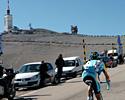
Recently on Cyclingnews.com |
Race Tech: Tour of California, February 19, 2008
By James Huang and Gerard Knapp
Shimano electronic Dura-Ace group heads closer to reality
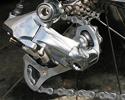
|
German rider Fabian Wegmann of Gerolsteiner tackled the first road stage of this year's Tour of California riding his usual Specialized S-Works Tarmac SL2 but with a version of Shimano's electronic Dura-Ace group that looked decidedly closer to a finished product than what we'd spotted previously.
Unlike earlier iterations that were rife with CNC-machined aluminium bits, this one relied heavily on what looked to be aluminium forgings. Forging is a process more typically associated with mass production than CNC machining (not to mention that it usually produces stronger parts) and forging dies are quite expensive which suggests that designs have likely been nearly finalized.
In particular, the rear derailleur has lost its once-chunky appearance and instead looks almost elegant. Plastic bits were also clearly moulded, not machined, and the polished finishes were in keeping with what we've come to expect from commercially available version of Dura-Ace, too.
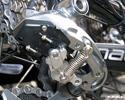
|
The front derailleur bore similar updates. Earlier machined aluminium bits have been replaced with smoother and highly polished ones (forged, we'd imagine) and the composite covers are notably more finished-looking. Even the cage bears a more refined look with deeper plating and more rounded edges. The battery looks largely identical to earlier version, but we'd guess that Shimano probably figured that one out quickly enough given that it doesn't have any moving parts.
Every aspect of the integrated brake/shift levers also suggested that this group is very close to production. The aluminium lever blade shape wore the same forged-and-polished appearance as on the rear derailleur and the overall aesthetic was far more refined that what we've seen before. Shift paddles have been fitted with highly detailed cut-outs and textures and each lever is equipped with the now-familiar tiny LCD gear and battery life indicators. More telling, though, is the subtle texture moulded into the rubber hoods that virtually screams 'production' (along with the logo on their side that had clearly been filed off).
Wegmann's bike was also equipped with PRO's Stealth Evo one-piece integrated carbon fibre bar and stem. That is hardly groundbreaking news in and of itself but the bar's internal cable routing does suggest that the group's electrical lines are easily detachable for such situations. We'd also be surprised if there weren't some sort of easy way to trim the lines to length if need be.
Saunier Duval-Scott readies for the week ahead
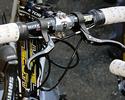
|
Some lingering injuries have forced Saunier Duval-Scott rider David Cañada to make some rather unorthodox modifications to his Scott Addict. Cañada is reported having some issues gripping the bars while in the hoods or drops and is currently spending far more time on the tops than usual. As a result, he wouldn't normally be able to quickly reach the brakes when riding in that position but team mechanics have fitted his bike with supplementary top mount levers that we normally see in 'cross. His bars have also been heavily wrapped for an easier grip and to provide some additional cushioning.
Cañada's bike otherwise looks to be inline with what his team-mates are also using although each bike was equipped with deep-section Mavic wheelsets that are no longer in production. The now-defunct Cosmic Carbone Pro use full-carbon 40mm-deep tubular rims roughly similar to what is used on Mavic's top-end Cosmic Carbone Ultimate.
That Cosmic Carbone Ultimate is normally built with co-molded carbon fiber spokes and hubs, though. In contrast, Saunier Duval-Scott's wheels were built with conventional nipples and stainless steel spokes laced to aluminium hubs along with 16 front/20 rear spoke counts.
So what is Rock Racing riding today?
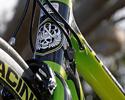
|
Rock Racing's remaining group of five was far more consistent in terms of equipment as compared to yesterday's hodge-podge of time trial gear. Mario Cipollini took off on his own special carbon machine but the remaining four riders were on stock DeRosa King 3 carbon frames, fully resplendent in fantastically showy iridescent green Rock Racing livery. Much as some would hate to hear us say this, these are easily some of the best looking bikes in the peloton this year.
Finishing kit was consistent as well, including Campagnolo Record componentry, Cole Products wheelsets and Stella Azzura bars and stems. Team bikes were also fitted with custom-covered fi'zi:k saddles and Look KeO pedals, although based on the experience each of those companies has reputedly had with Rock Racing in the past we'd guess that the team simply purchases those items on its own.
Speedplay has the numbers in California
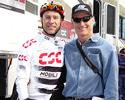
|
When Fabian Cancellara (Team CSC) stormed across the line to take out the opening prologue of the Tour of California, he kicked off a great start of the American stage race for his team and especially one of its equipment suppliers, the California-based pedal manufacturer, Speedplay. Then again, Speedplay does have the numbers in its favour at this year's Tour of California as there are more professional cyclists riding its Zero pedals than any other brand in the race.
Speedplay-equipped teams include reigning Pro Tour champions Team CSC, as well as the USA Cycling National Racing Calendar (NRC) champions Health Net/Maxxis. Team Bissell (formerly Priority Health) also has a long-standing relationship with Speedplay and is joined at this year's event by BMC, Kelly Benefit Strategies-Medifast and Jelly Belly. Included among the other teams that will race on Speedplay pedals this year are Team Type 1, Jittery Joe's, Sean Kelly Cycling Academy Team, Team DLP, Cervélo/Life Force and Webcor Builders.
"We are extremely proud to be represented by so many world class professionals racing on our pedals. Since Speedplay only makes pedals, it is especially gratifying to have these teams single us out as their pedal choice," said Speedplay's Sharon Worman.
Photography
For a thumbnail gallery of these images, click here
Images by James Huang/Cyclingnews.com
- Fabian Wegmann's bike was normal looking enough but was fitted with what looked to be the latest iteration of Shimano's pending electronic Dura-Ace group.
- Shimano's electronic Dura-Ace group makes another appearance, although this time it looks a lot closer to production than before.
- Previously machined aluminum bits have now been replaced with smoother and more highly polished pieces that look to be forged.
- The overall configuration is largely unchanged from what we've seen already but the composite bits wear a far more refined appearance.
- The front derailleur boasts a similarly updated appearance as on the rear derailleur.
- Cage plating is thick and the corners are well-rounded.
- The composite shell looks like it fits more precisely and cleanly than previous iterations.
- The electronic Dura-Ace levers were spotted with smoothly contoured blades and the shift paddles have far more detail than before.
- Shimano devotees with be happy to see that these prototypes still include that distinctive bulge at the top of the levers that are so handy to hold on to.
- Hoods look like production bits as well as shown by their subtle texture that is molded right in.
- Hmm… was there a logo here?
- Levers still include gear indicators and a small battery life meter.
- In spite of their finished appearance , these are obviously still pre-production test mules.
- Gerolsteiner mechanics fitted the battery down low near the bottom bracket.
- The battery's location required that the seat tube-mounted bottle cage be shifted upwards via a custom bracket.
- As you'd expect, there are multiple cable connections but these are necessary to facilitate internal cable routing such as on Fabian Wegmann's bike.
- More connections can be found on the down tube.
- Don't worry, electronic Dura-Ace looks to still be 10-speed compatible.
- Astana hits the road aboard its new Trek Madone 6.9 rocket ships.
- Levi Leipheimer won the Tour of California last year and set off on a specially painted Trek Madone 6.9 that made no illusion of his country of origin.
- Stars, stripes and red, white and blue livery adorned Leipheimer's machine.
- Astana may be the capitol of Kazahkstan , but Leipheimer's bike was all American.
- Some Astana riders were equipped with SRAM power meters (which use SRM hardware)…
- while others opted for the lighter SRAM Red crankset.
- Astana rider José Luis Rubiera hits the road with this companion.
- The Bontrager Aeolus 5.0 tubular was Astana's wheel of choice for Stage 1.
- Even the team's number holders are carbon…
- …but its steerer tubes are not. This one was clearly aluminum.
- Rooftop racks here in the US bore a decidedly commercially available look as opposed to the custom jobs in Europe.
- Saunier Duval-Scott's Scott Addict bikes head into 2008 with a bright new paint job.
- A fleet of Scott Addicts await the start of Stage 1.
- Saunier Duval-Scott preferred to run with Mavic's older Cosmic Carbone Pro wheelsets.
- Full carbon tubular rims are laced to aluminum hubs with stainless steel spokes and standard nipples.
- The carbon braking surfaces were handled by carbon-specific pads based on SwissStop's Yellow King.
- Saunier Duval-Scott's David Cañada is reportedly having some grip issues due to injury.
- Cañada's bars were heavily wrapped for an easier grip and more shock absorption.
- Very unusually, though, Cañada's bars are also fitted with top mount brake levers so he can brake safely where he's most comfortable gripping the bars.
- Camelbak bottles debut in the ProTour aboard the bikes of Saunier Duval-Scott.
- Some old habits die hard. In spite of the team's official SRAM sponsorship, some riders were still running Stronglight chainrings.
- Rock Racing megastar Mario Cipollini set off on his own distinctive ride.
- Anyone care to guess when Cipollini was born?
- Cole Products is Rock Racing's official wheel sponsor.
- The rest of Rock Racing's crew departed for Stage 1 on these hot looking DeRosa King 3 rigs.
- Say what you want about how Rock Racing is conducting itself, but damn, these things look good.
- Rock Racing logos are littered throughout.
- Another Rock Racing logo can be found on the back of the integrated seatmast.
- Neon green is the color of choice for Rock Racing… at least for now.
- Team bikes are fitted with Stella Azzura stems.
- Quick Step tackled Stage 1 aboard Specialized's latest S-Works Tarmac SL2 bikes.
- The S-Works Tarmac SL2 comes with the now popular tapered and oversized 1 1/8"-to-1 1/2" front end.
- Quick Step has swapped last year's Fulcrum wheels for Roval hoops from bike sponsor Specialized.
- The Roval wheels use a number of interesting features , not the least of which is the DoubleDrive lacing pattern.
- Specialized has gotten Quick Step to use its wheels now but the team still perches itself atop its own saddles.
Images by Gerard Knapp/Cyclingnews.com
- The developer of the Speedplay pedal, Richard Bryne , proudly points out the equipment used on one of the Team CSC time trial machines, in this case the bike belonging to German rider Jens Voigt.
- Richard Bryne poses with Jen Voigt outside the Team CSC camp at Palo Alto before the start of the opening prologue of the Tour of California. Bryne is a regular visitor to the training camps and documents many behind-the-scenes moments with his digital camera and then shares the images on
Images by James Huang/Cyclingnews.com
- Toyota-United has swapped over to Fuji Bicycles after racing on its own brand of machines in years prior.
- Deep-section wheels were a popular choice during Stage 1 of this year's Tour of California.
- Toyota-United's wheels are a mix of both tubular and clincher flavors.
- Credit Agricole soldiers on with its proven Look 595 frames.
- Team High Road raced aboard its new Giant TCR Advanced SL bikes for the first time.
- All bikes were equipped with GPS transceivers to provide real-time positioning data. It's a shame that organizers couldn't find something a bit more understated, though.
- Tom Ritchey made an appearance at the start of Stage 1.
Images by Gerard Knapp/Cyclingnews.com
- Team CSC's Bobby Julich warms up prior to the start of the opening prologue of the Tour of California; note the O.Symetric chainrings that he often uses for time trials.
- It seems that the richer the town , the more well-equipped its cycling eccentrics. This specially built 'chair' for the faithful English bulldog was a major centre of attention in Palo Alto.
- 'Old iron' may be back in vogue in northern California , but for some riders, they never left. Here, Jim Thompson shows off his immaculate 1975 Richard Sachs special, the sixth-ever bicycle produced by the venrable American bicycle-maker, and it still has the original paintjob.
- The Continental tyres - not singles or tubulars - are a concession to the owner's everyday use of this trusty steel frame, the sixth frame to be produced by Richard Sachs in 1975.
